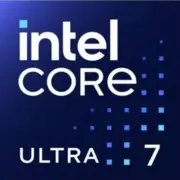Intel Core Ultra 7 165U

Intel Core Ultra 7 165U: The Perfect Balance for Mobility and Performance?
Review of the Meteor Lake Processor for Ultrabooks in 2025
Architecture and Process Technology: A New Level of Efficiency
The Intel Core Ultra 7 165U processor, built on the Meteor Lake architecture, is the company's first mass-market chip to fully adopt a 7-nm process (Intel 4). This has significantly improved energy efficiency and transistor density.
Hybrid Core Structure
- 12 cores (6 P-cores + 6 E-cores) and 14 threads:
P-cores (Performance) are high-performance cores with Hyper-Threading (12 threads), a base frequency of 3.8 GHz, and a turbo boost of up to 4.9 GHz.
E-cores (Efficient) are energy-efficient cores without multithreading, operating at frequencies of up to 3.2 GHz.
This approach optimizes task distribution: heavy applications (e.g., Photoshop) load P-cores, while background processes (updates, streaming) are handled by E-cores.
Integrated Graphics Xe LPG 128EU
The Xe-LPG graphics module replaces Iris Xe. With 128 execution units (EU) and support for DirectX 12 Ultimate, it is capable of running games at 1080p on low settings. For instance, Fortnite delivers a steady 45-50 FPS.
NPU for AI Tasks
For the first time in Intel processors, a neural processing unit (NPU) has been introduced to accelerate AI operations. This is particularly useful in applications with background noise cancellation (Zoom, Teams), automatic photo retouching (Luminar Neo), or energy consumption optimization.
Power Consumption and TDP: The Fine Line Between Power and Endurance
With a TDP of 15W, the Core Ultra 7 165U is ideal for ultrabooks. However, during peak load (turbo mode), power consumption can reach up to 35W, necessitating a high-quality cooling system.
Power Management Technologies
- Intel Thread Director: Dynamically distributes tasks between P-cores and E-cores, preventing overheating.
- Adaptix Power Optimizer: Uses AI to predict workload and reduce voltage on cores during idle periods.
Performance: Faster Than Predecessors, but Not Without Compromises
Office Tasks and Multimedia
- PCMark 10: 5800 points — 18% higher than the Core i7-1260P (2022).
- Rendering 4K video in DaVinci Resolve takes 9 minutes (compared to 12 minutes for the Ryzen 7 7735U).
Gaming
- CS2 (1080p, low settings): 75-90 FPS.
- The Witcher 3 (720p, low settings): 35-40 FPS.
For comfortable gaming on AAA titles, an eGPU (e.g., Razer Core X + RTX 4060) will be required.
Turbo Mode: Pros and Cons
When turbo mode (up to 4.9 GHz) is activated, performance in single-threaded tasks (e.g., Excel) increases by 25%, but after 2-3 minutes, the frequency drops to 4.2 GHz due to overheating in slim chassis.
Use Cases: Who is the Ultra 7 165U For?
- Mobile Professionals: Lawyers, copywriters, analysts working with documents and video conferencing.
- Students: Suitable for studying, streaming video, and light presentation editing.
- Travelers: Compact laptops with this CPU weigh from 1.2 kg and fit in a backpack.
Do not choose this processor if:
- You are engaged in 3D modeling (consider the Core Ultra 9 185H or Ryzen 9 8945HS instead).
- You play demanding games (look for laptops with the RTX 4050).
Battery Life: Up to 14 Hours in Mixed Mode
Under moderate load (web browsing, Office 365), laptops with the Core Ultra 7 165U operate for 10-12 hours. In power-saving mode (50% brightness, Wi-Fi) — up to 14 hours.
Energy-saving technologies:
- Display Power Savings: Automatically reduces the screen refresh rate to 60 Hz.
- Smart Standby: Disables unused cores during idle periods.
Comparison with Competitors: The Platform Battle
AMD Ryzen 7 8840U (Zen 4c, 5 nm)
- Pros: Better multi-threaded performance (10200 points in Cinebench R23).
- Cons: Weaker graphics (Radeon 780M is 15% behind Xe LPG).
Apple M3 (3 nm)
- Pros: Record battery life (18+ hours), optimized for macOS.
- Cons: Limited compatibility with Windows applications.
Intel Core Ultra 5 155U
- Budget alternative: 10% cheaper, but 20% weaker in multi-threaded tasks.
Pros and Cons of the Core Ultra 7 165U
Strengths:
- Ideal for thin laptops.
- Xe graphics handle light gaming well.
- NPU accelerates AI tasks.
Weaknesses:
- High price: Laptops start from $1200.
- Turbo mode is unstable in compact devices.
Recommendations for Laptop Selection
- Type of Device: Ultrabooks (e.g., Dell XPS 14 2025, Lenovo Yoga Slim 7 Pro).
- What to Check:
- RAM size: From 16 GB LPDDR5X.
- SSD: At least 512 GB PCIe 4.0.
- Screen: IPS or OLED with a resolution of 2.8K.
- Example Prices:
- ASUS Zenbook 14X (16GB/512GB) — $1299.
- HP Spectre x360 14 (32GB/1TB) — $1599.
Final Conclusion: For Whom is the Core Ultra 7 165U Created?
This processor is a sweet spot for those who value portability but are not willing to sacrifice basic performance. It is suitable for:
- Freelancers working in cafes or co-working spaces.
- Users who need a versatile laptop for study and leisure.
- Those who prefer quiet systems without loud fans.
Key Benefits: Power for everyday tasks, 14 hours of battery life, and the ability to run light games without discrete graphics. If your budget is $1200–$1600 and you are not chasing extreme performance — the Core Ultra 7 165U will be an excellent choice for 2025.
Basic
CPU Specifications
Memory Specifications
GPU Specifications
Benchmarks
Compared to Other CPU
Share in social media
Or Link To Us
<a href="https://cputronic.com/cpu/intel-core-ultra-7-165u" target="_blank">Intel Core Ultra 7 165U</a>